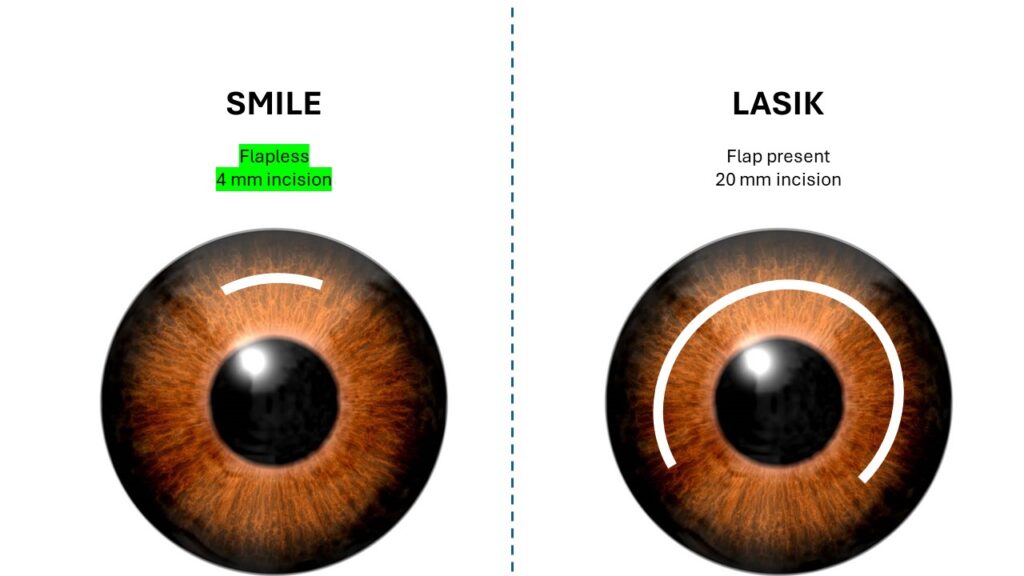Myopia, commonly known as nearsightedness, is a widespread refractive error that affects millions of people worldwide. In fact, the prevalence of this condition has been on the rise for quite some time. A study indicates that ~50% of the world will be myopic by 2050.
This condition makes distant objects appear blurry while close objects can be seen clearly.
As an ophthalmologist, I often encounter patients concerned about their worsening vision and their constant dependence on glasses. Most of them are eager to explore treatment options, especially ones that lead to getting rid of their glasses permanently. In this post, we will delve into the causes of myopia, its symptoms, and the available treatment options.
What Causes Myopia?
Myopia occurs when the eye’s shape causes light rays to bend incorrectly, focusing images in front of the retina instead of directly on it. This can result from:
- Elongated Eyeball: A longer-than-normal eyeball can cause light to focus in front of the retina.
- Curved Cornea: An overly curved cornea can also lead to improper focusing of light.
- Genetic Factors: Myopia often runs in families. If one or both parents are nearsighted, there is a higher chance of developing the condition.
- Environmental Factors: Prolonged close-up work, such as reading or using digital screens, can contribute to the development and progression of myopia.
Symptoms of Myopia
The primary symptom of myopia is difficulty seeing distant objects clearly. Other signs include:
- Squinting
- Eye strain
- Headaches
- Difficulty seeing while driving, especially at night (night myopia)
Treatment Options for Myopia
- Eyeglasses and Contact Lenses
- Eyeglasses: The simplest and most common solution. If your power is on the higher side, it is suggested to use high-index glasses.
- Contact Lenses: An alternative to eyeglasses, contact lenses offer a wider field of vision and are particularly useful for active individuals. Contact lenses are better in terms of vision quality and cosmesis. However, a word of caution, if used inappropriately, it can lead to severe vision-threatening complications.
- Orthokeratology (Ortho-K)
- Ortho-K: This non-surgical procedure involves wearing specially designed rigid contact lenses overnight to temporarily reshape the cornea. It can reduce the need for glasses or contacts during the day. It is considered obsolete now
- Refractive surgeries: Myopia is one of the most common indications of refractive surgeries. There are multiple options available for myopia. Not all are suitable for everyone. Your ophthalmologist will have to perform multiple tests/evaluations before recommending the right option to you. Here are the few most common options available:
- Laser-Assisted In Situ Keratomileusis (LASIK): A popular refractive surgery that reshapes the cornea using a laser, correcting the focusing issues that cause myopia. LASIK offers rapid recovery and excellent visual outcomes for many patients. LASIK is of two types: Microtome assisted LASIK and Bladeless LASIK- the latter providing an advantage of femto laser driven flaps – thus reducing the flap complications significantly
- SMILE (Small incision Lenticule Extraction): A relatively newer and more advanced surgery wherein a small lenticule is created inside the cornea using a femtosecond laser, which is then removed through a small incision. It is completely bladeless and flapless. My mentor, Dr Sri Ganesh was one of the pioneers of SMILE surgery. This is definitely one of the safest options if you are eligible
- Photorefractive Keratectomy (PRK): Another laser surgery option that reshapes the cornea, similar to LASIK. It is suitable for patients with thin corneas who may not be ideal candidates for LASIK.
- Implantable Collamer Lenses (ICL) or Phakic IOLs: A surgical option where a lens is implanted inside the eye without removing the natural lens. This option is suitable for patients with high degrees of myopia or thin corneas.

Other complications:
Myopes are at higher risk for certain eye conditions such as glaucoma, retinal tears, retinal detachments, etc.
If you are a myope, we would strongly recommend you to have an annual examination with your ophthalmologist
Conclusion
Myopia is a very common but manageable condition with various treatments which are usually personalised. While spectacles are a perfectly acceptable solution, refractive surgeries have never been safer thanks to cutting-edge technology and highly trained surgeons. However, remember it is important that a trained ophthalmologist performs a thorough evaluation before she can recommend the best option for you.
At Arham Eye Care, we offer comprehensive eye exams and personalized treatment plans to help you achieve optimal vision. If you have concerns about your vision or want to explore treatment options, feel free to contact us for a consultation.
-Dr Hemali Doshi
MS Ophthalmology (Gold Medalist), FPRS (Fellowship in phacoemulsification and refractive surgery)
